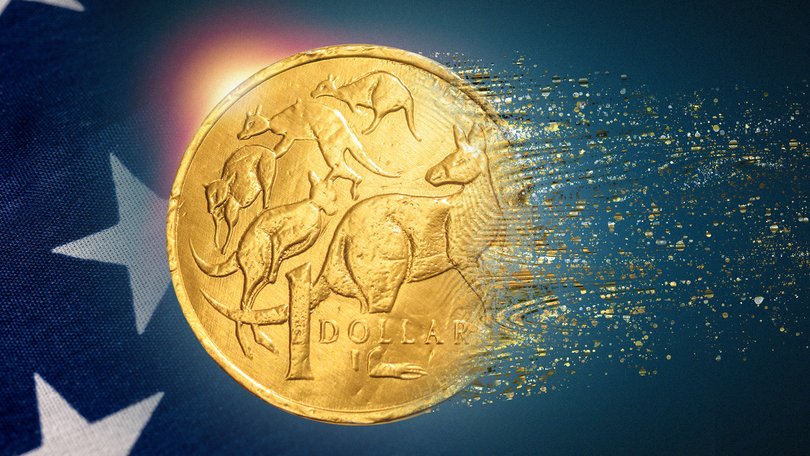Australian economy: Why the falling Aussie dollar is a rate cut headwind

A blockbuster jobs report out of the US on Friday has pushed to Australian dollar towards a five-year low, prompting concerns that imported inflation will make the Reserve Bank’s interest rate decision more difficult.
The Aussie dollar dropped to 61.4 US cents as expectations about a US rate cut evaporated on stronger-than-expected employment data, down 9 per cent in the last six months.
The AUD has not fallen to these lows since the height of COVID when it touched just under 58 US cents, while it is now lower than the fall during the Global Financial crisis.
Sign up to The Nightly's newsletters.
Get the first look at the digital newspaper, curated daily stories and breaking headlines delivered to your inbox.
By continuing you agree to our Terms and Privacy Policy.Outside emergency settings, the last time the Australian dollar dropped below its current level was April 2001 when it fell below 50 US cents as the dot com bubble expanded in the US while Australia entered a recession.
Dollar buffeted by global forces
The trigger for the fall was a far stronger-than-expected US jobs report that showed employers added more than a quarter of a million jobs in December, pushing down the unemployment rate. Along with the jobs data, a consumer survey showed that inflationary expectations had risen.
That data made a number of major investment banks change their forecast for US interest rate reductions, while one bank suggested there could be a rate hike.
The latest data has put further upward pressure on long-term US bond yields, which are heading towards five per cent - a figure briefly touched in 2023 but otherwise unheard of since before the global financial crisis nearly two decades ago.
The rise in 10-year US treasury yields has some worried that there is a return of so-called ‘bond vigilantes’.
These traders, who actively sell off bonds in response to what they perceive as unsustainable fiscal or monetary policies, have had an outsized impact on economic policy, including the eurozone debt crisis in the 2010s and the UK government bond sell-off in 2022, that precipitated the resignation of Prime Minister Liz Truss.

This time, the bond markets appear to be sending a message about the inflationary impact of continued strong growth amid Trump’s proposed tariffs, as well as the enlarged Federal debt as a result of Trump’s tax policies.
The UK has also seen a spike in bond yields to 15-year highs over concerns the Labour government’s budget deficit is unsustainable. In a cruel twist of fate, the 10 billion pounds of breathing room left by Chancellor Rachel Reeves in her last budget now looks likely to be wiped out by higher interest costs on government debt as a result of the steepening bond yields.
In contrast with the US however, the higher bond yields have not pushed up the price of the pound as investors have been selling UK assets for fear that the government may have to raise more taxes or slash spending to get the debt under control. That would limit the UK’s growth potential.
While bond yields are rising in the US and elsewhere, they are going in the opposite direction in China.
Despite repeated attempts to stimulate the economy, traders are increasingly nervous that the Middle Kingdom is headed towards “Japanification on steroids”, where a slowing economy and demographic headwinds are pushing inflation towards zero.
Last week, factory deflation continued for the 27th straight month, while consumer prices rose a scant 0.1 per cent. A deflationary economy is one where consumers will hold back from spending on the expectation goods will be cheaper later, hurting growth and investments.
As the main driver of Australia’s export income, a deflationary, low-growth environment in China will flow through to the Australian currency.
These twin factors, pushing in opposite directions, have combined to put continued downward pressure on the dollar.
“We’re at levels now when Paul Keating made his Banana Republic speech in 86,” Warren Hogan economic advisor to Judo Bank said.
“The only time the Aussie dollar against the US dollar has been weaker has been in extraordinary circumstances, whether it’s the start of the pandemic, whether it’s the GFC or whether it was the tech boom at the turn of the century, when the whole world thought we were an old economy. with commodities that nobody was interested in.
“We are at alarming levels on our currency.”
Inflationary impact a concern for RBA
The clamour for interest rate relief continues to grow, and markets have raised their forecast for a February cut to 75 per cent, but Hogan believes that to do so would be premature and possibly damage the RBA’s credibility.
“The RBA will be looking at the rise in the US 10-year bond and say, ‘that’s telling us that the markets are concerned’,” Mr Hogan said.
“There’s more inflation, more growth over there that’s going to have a positive impact on Australian inflation and growth.”
That international inflation is one concern, but at the level of the Australian dollar, imported inflation becomes even more of a problem.
“The weakness in the currency is not just against the US dollar but against a range of currencies,” he said.
“A lower currency is going to create more inflation pressure in the economy because the cost of imported goods goes up.
“I’ve been speaking to a lot of retailers, and because demand in the economy is actually okay, importers are passing on the currency impact.”
Christian Baylis, chief investment officer of Fortlake Asset Management and a former RBA economist, shares a similar view, citing the fall against the euro as another concern.
“The currency assumptions in the RBA’s forecasts are well out of the money,” he said.
“None of this helps the RBA, especially when you have an unemployment rate near multi-decade lows.”
Mr Baylis and Mr Hogan both believe that a major risk for Governor Michele Bullock is celebrating a disinflation victory too soon, then being forced to hike rates, or rapidly change its tune.
“There is a big chorus for interest rate cuts but the labour market is the party stopper,” he said.
“The RBA won’t want to fall into the same trap as the Federal Reserve, celebrating victory when the same fundamental patterns are happening in both our labour markets.”
Mr Hogan pulled no punches, saying the inflationary rise was too great.
“The worst case scenario, as I see it, is that they cut in February and then they are forced into a humiliating reversal and have to start hiking again in the second half of the year.
“That damage to Australia’s and the RBA’s credibility will potentially cost us, as a community, billions of dollars over the years ahead in a weaker and weaker currency and higher interest rates. I think it’s madness.”

